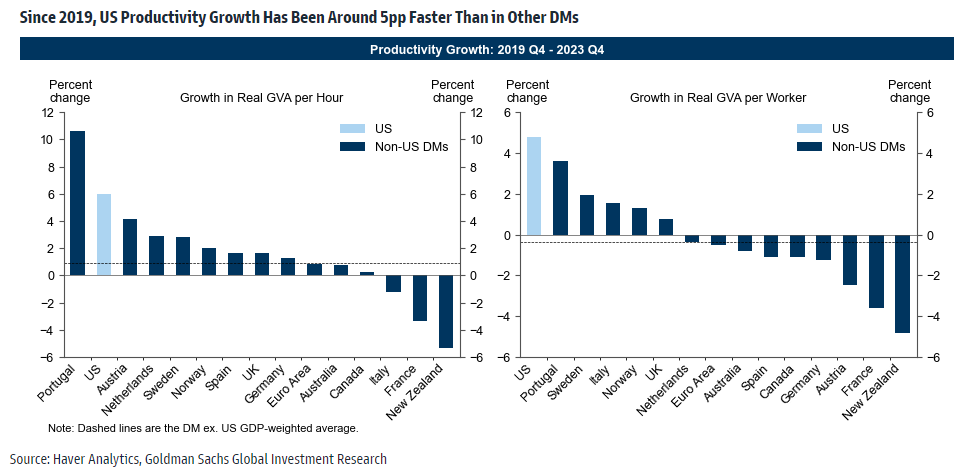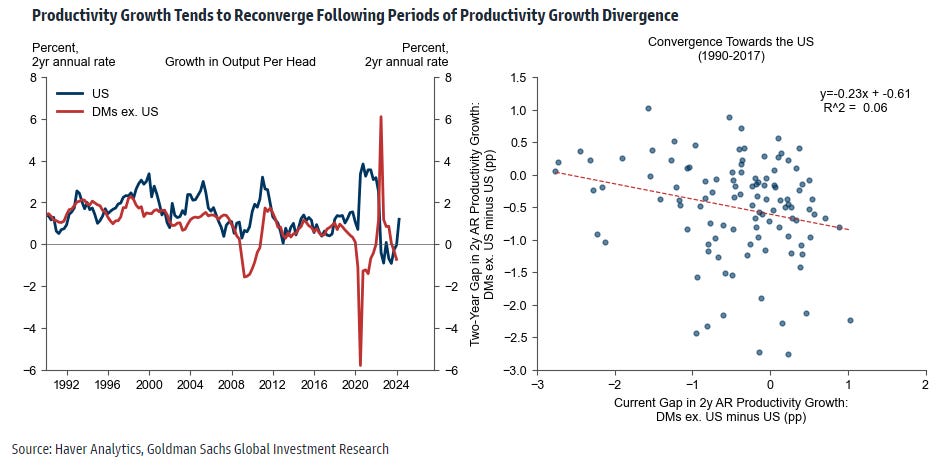Explaining the Recent Productivity Gap between the US and Europe
May 25, 2024
Recently I’ve been using the Saturday issue of this newsletter to highlight Up Wing and Down Wing things, pro-progress and anti-progress news items, from the week that was. I hope you find it valuable.
But in addition to that today, I wanted to briefly address an economic mystery that’s been on my mind: Why has US productivity growth been so much better than other rich economies over the past five years? While productivity growth among countries can vary due to differences in many factors — technology adoption, human capital investment, government regulation, among others — this gap seems quite large and quite sudden.
Interregnum: I write a lot about productivity growth, which is what happens when a country, industry, or company finds ways to produce more goods and services using the same amount (or less) of resources, such as workers, machines, and raw materials. Over the long run, productivity is what drives higher living standards. It’s about working smarter, not just harder, to create a more prosperous future. I love productivity growth, and so should you.
So here’s the deal: Since the end of 2019, productivity in the US has cumulatively outgrown other advanced economies by around 5 percentage points, or around 1.25 points on a four-year annualized basis, as this Goldman Sachs chart from a new report by the bank shows:
In particular, I would note the difference between US productivity growth and that seen in large European economies such as the UK, Germany, and France. While the US is really its own thing — to quote Rocket Raccoon, “Ain’t no thing like me, except me!” — those comparisons are the most valid. Anyway, here is the GS explanation for the gap:
- First, the productivity gap between the US and other advanced economies that has widened since the COVID-19 pandemic is not entirely a new phenomenon. About half can be traced back to structural differences that were already present before the pandemic. These underlying factors seem to have persisted. Among the ones highlighted by GS: “tighter credit constraints and weak investment post-GFC, weaker balance sheets, the survival of zombie firms, slower technology diffusion, and input misallocation across industries and firms all likely weighed on productivity growth in the Euro area.” The bank also notes that “in the UK and Canada, weak productivity growth among information and tech firms — possibly reflecting weaker competitive pressure — disproportionately contributed to the underperformance relative to the US.”
- Second, productivity divergence may be partly due to an overestimation of US productivity gains by around 1.2ppt, or annualized growth is overstated by 0.3ppt. This, GS points out, is because of recent changes in methodology that incorporate “off-the-clock” hours, which refer to time spent working that is not officially recorded or compensated, which could mean that government stats are underestimating total US hours worked and thus overestimating output per hour,
- Third, post-pandemic labor market differences between the US and other advanced economies have also likely contributed to the productivity growth divergence. The US and Canada laid off workers with generous unemployment benefits, while other countries maintained worker-firm relationships, potentially suppressing efficient labor reallocation as workers shifted to new employers. “Particularly in Europe, firms have reduced hours worked rather than laying off workers (thereby avoiding layoffs and costly rehiring) given the combination of weak demand but a tight labor market.”
- Fourth, several country-specific factors are contributing to the divergence. In Canada and Australia, a huge wave of immigration has likely slowed down productivity growth. (“In the near term, recent immigrants tend to find employment in lower productivity sectors and attract lower wages than natives in comparable occupations.”) In France, the government has been offering generous subsidies for apprenticeship programs. This has led to a big increase in young people aged 15-24 joining the workforce. Since these new workers are just starting out, they might not be as productive right away. Moreover, Germany has been dealing with some lingering supply chain issues that are holding back productivity, especially in industries that use a lot of energy.
Moving forward, GS sees the productivity gap partly closing over the coming quarters:
First, the divergence in hours worked between the US and its peers should partly retrace as activity picks up and labor markets continue to rebalance, thus weakening the labor hoarding motive that has disproportionately lowered productivity in non-US DMs.
Second, many of the factors we outlined – including the level effect of labor reallocation to more productive industries, supply-side disruptions, and changes in the labor force composition – are one-off in nature and should affect the level, but not the future growth rate of output per worker.
Third, historical evidence suggests that large deviation of US productivity growth from other DMs have been rare in nature over the last 40 years. And, when productivity growth rates did diverge meaningfully, they generally converge over the next two years, possibly reflecting a convergence in competition or technology diffusion.
Our analysis therefore supports our view that productivity growth in non-US DMs will pick up over the course of 2024, consistent with our forecasts that non-US GDP growth will accelerate to 1.5% in 2024 and 2025 on a Q4/Q4 basis (vs. 0.4% current year-on-year growth).
All of which leads to another economic mystery: Will US productivity growth, up nearly 3 percent over the past year, sustain its recent strengthen or slip back into its 1.5 percent annual pace seen since the Global Financial Crisis? If it’s the former, AI advances will likely be playing a key role, as I have been writing about:
🗽💨 America is outgrowing other rich countries, thanks to the ‘American Tailwind’
🦁 My chat (+transcript) with investment strategist Ed Yardeni on his optimism for a Roaring 2020s
⏩ We can do it! How our decisions can accelerate economic growth
🤖🌊 How close is the transformational AI wave?
⤴⤵ Up Wing/Down Wing #4
⤴ Up Wing Things
⚕ Semaglutide, the active ingredient in Ozempic and Wegovy, was found to significantly reduce the risk of kidney complications, heart issues, and death in people with Type 2 diabetes and chronic kidney disease. The study, which included 3,533 participants, showed that those receiving semaglutide had a 24 percent lower chance of severe kidney events compared to the placebo group. Novo Nordisk plans to seek FDA approval to expand Ozempic’s use for slowing chronic kidney disease progression. (New York Times)
💻 Quantum computers from IBM and D-Wave have already outperformed the world’s top conventional computers in specific tasks, despite being error-prone. Quantum computers use qubits which, unlike the binary system of other computers, can exist in a complex state between 0 and 1. These machines can perform calculations far faster than traditional computers and could revolutionize fields like molecular engineering and internet security by solving complex optimization problems. Researchers are exploring practical applications such as optimizing logistics, enhancing AI, and solving medical problems, with hopes that continued experimentation will yield significant breakthroughs. (Wall Street Journal)
🧠 A second person has been approved by the FDA to receive Elon Musk’s Neuralink brain implant chip after addressing issues from the first trial. The first participant, Noland Arbaugh, a paraplegic, experienced a setback as the device initially allowed him to control a computer cursor with his thoughts but later malfunctioned when most threads came loose. Of the device’s original 64 hair-width external threads, only around 15 percent remain in place. Neuralink’s future solutions include embedding wires deeper into the brain, which the FDA has approved. Despite setbacks, Arbaugh regained many device capabilities through software adjustments and remains hopeful. Neuralink plans to implant ten more participants this year and expand trials to Canada and Britain. (Wall Street Journal)
🧬A new gene therapy shows promise in treating back pain by repairing spinal discs, the degeneration of which was previously near-impossible to reverse. The therapy, developed by Ohio State University researchers, uses nanocarriers loaded with the gene FOXF1 to rejuvenate disc tissue, resulting in improved spine function and reduced pain symptoms. Tests on mice showed significant improvements in disc structure and flexibility, raising hopes for a future treatment for chronic back pain in humans. Further research will focus on testing the therapy in older mice with age-related disc degeneration. (New Atlas)
🚀 Blue Origin resumed space tourism flights on its first tourist mission since August 2022. Among its six passengers was Ed Dwight, the first black astronaut candidate, originally selected for space flight in 1961, but never ultimately flew with NASA. The launch, a short trip over 60 miles above Earth, follows a hiatus to investigate and correct an engine failure in September 2022. The company has now completed seven tourist missions and aims to launch the more powerful New Glenn rocket and send humans to the moon for NASA later this decade. (Bloomberg)
⚡ A new therapy using electrode pads helps spinal cord injury patients improve hand and arm function. Over two-thirds of study participants saw improvement. The pads deliver electrical stimulation to the spinal cord during rehabilitation exercises, enhancing nerve excitability and promoting lasting improvements. The treatment, suitable for those with partially intact spinal cords, has shown promising results, with many participants experiencing significant gains in hand strength and function. (New Scientist)
⚛ The European Space Agency is set to use a pioneering nuclear-powered device for its upcoming ExoMars mission. The Mars rover (Europe’s first) will harness americium-241 decay to keep components warm. This marks the first use of americium in space and follows a new collaboration with NASA after ESA ended its partnership with Russia’s Roscosmos following the invasion of Ukraine. The americium-powered Radioisotope Heater Units (RHUs) will heat the mission’s lander, enhancing its lifespan and reliability. By 2028, ESA aims to have americium batteries ready for future Moon missions, significantly expanding their exploration capabilities. (Nature)
✈ The world’s first winged commercial spaceplane is preparing for its first mission to the International Space Station (ISS). The Dream Chaser DC-100 spaceplane, named Tenacity, has arrived at NASA’s Kennedy Space Center for final preparations before its mission, planned for later this year. Attached to a United Launch Alliance (ULA) Vulcan rocket, it will deliver 7,800 pounds of supplies to the ISS: “Tenacity will be the first of a fleet of versatile, reusable lifting-body spaceplanes designed for these low-orbit ‘delivery runs.’” (New Atlas)
⤵ Down Wing Things
🗽 Trump’s immigration plans, which include mass deportations and expanded border control measures, aim to strengthen the US economy by reducing competition for jobs and wages. Economists and business leaders warn, however, that these measures could lead to higher unemployment, slower economic growth, and increased inflation, especially affecting key industries like construction and agriculture that rely heavily on immigrant labor:
“Recent estimates from the Congressional Budget Office said that the U.S. labor force will have grown by 5.2 million people by 2033, thanks especially to net immigration, and that the economy will grow by $7 trillion more over the next decade than it would without new immigrants.” (Washington Post)
💲 A Senate report warns that the combination of effective weight-loss drugs, their staggering cost, and the high US obesity rate could “bankrupt” the healthcare system. If just half of American adults with obesity used weight-loss drugs like Wegovy, it would cost an estimated $411 billion per year, surpassing all 2022 prescription drug spending. (Ars Technica)
🤖 California’s State Senate has passed SB 1047, a bill to regulate AI, which could significantly impact AI development with measures such as criminalizing end-user misconduct and imposing substantial costs on developers. The bill establishes the Frontier Model Division under California’s Department of Technology to oversee models trained with substantial computing power, requiring developers to ensure their models cannot be used for harmful purposes. This regulation will hinder open-source AI development and discourage startups. (Hyperdimensional)
🤖 Colorado and Connecticut have introduced aggressive AI regulation bills aimed at preventing discrimination in critical services such as healthcare, employment, and housing. Connecticut’s bill was quickly discarded following Governor Ned Lamont’s veto threat. Lamont cited concerns over suppressing the new industry. Colorado’s bill faces significant opposition from the tech lobby, which opposes state-by-state legislation. Amid great uncertainty, over 40 states are currently considering a cumulative 400-plus AI-related bills. (Politico)
Sign up for the Ledger
Weekly analysis from AEI’s Economic Policy Studies scholars







